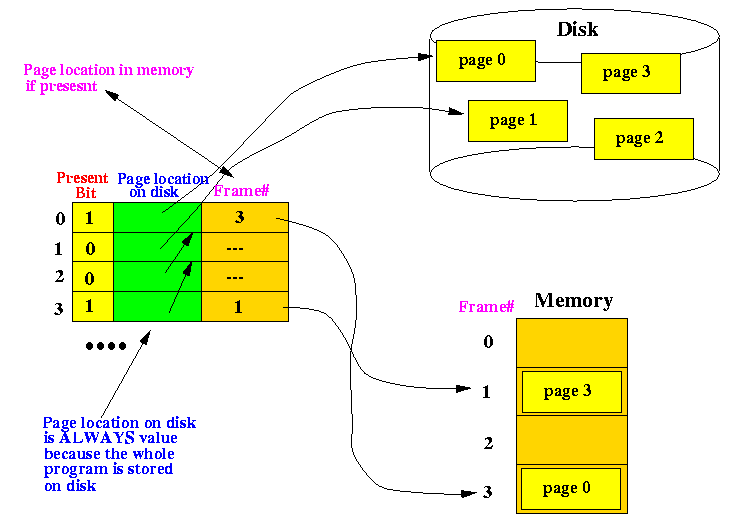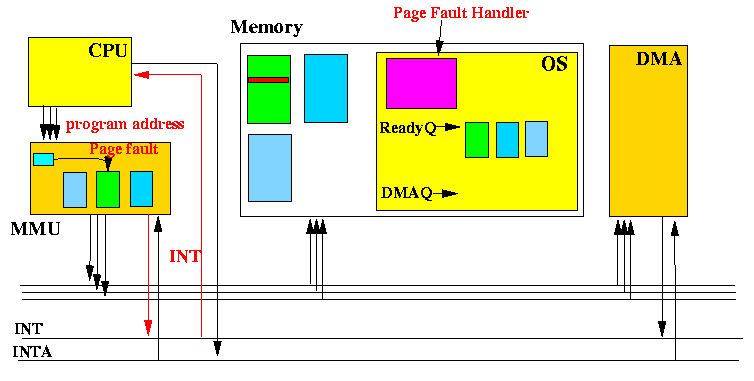Programs usually consists of many loops and the program runs a long time in one loop.
While the program is inside one loop, it only need instructions that comprises that loop and do not need other instructions.
Hence, only a few program pages need to be present in the memory while the program is executing in some loop.
When the program leaves that loop and executes inside another loop, the computer will fetch other pages from disk and replace those pages in memory from the previous loop
- A detection method to determine whther the page containing
the instruction or variable is presently in memory or not
- If the page is not present, then execute a program (subroutine) to fetch the page from disk.
- Recall that the page table entries contains a
present bit:

- The page is present in memory if the present bit for that
page is ONE (1), and otherwise, the present bit is ZERO.
- We can easily determine if a page needed by the CPU is present in memory or not.
- When the CPU tries to access a program location from a page that is not present in memory, we say that a page fault occurs.
- When a page fault is detected (using the present bit in the page table),
the program cannot continue execution until the needed page
is read in from disk.
- Note that the page is stored on disk and
must be read from disk and
the disk is sloooooow....
- Note that this situation is
the same
as when the program would read data from disk to perform
processing.... (the effect is that the program cannot continue
because it must wait for the IO transfer !!!)
- So we
know how to handle this efficiently !!!
- DMA !!!
In order to stop a program so that it can be restarted later from the point where it is stopped, you need to save the context information (see: click here)
Afterwards, another (ready) program is run (while the DMA performs the IO transfer on behave of the stopped program).
- The MMU contains many page table data structures
(for many different programs).
- The MMU has a special "current page table" register that points to the
page table used to translate program addresses from
the current program:

- Each page table is set up by the Operating System.
- Initially, the present bit of all entries are ZERO and the location of the pages on disk are initialized (the Operating System allocates the pages on disk and set up the location in the page table)

- This figures shows 3 running program in the system.
- The current program executing on the CPU is the program
at the head of the Ready Queue
- The current page table register in the MMU must also points to
the page table used by the current program.
That page table will translate program address into memory addresses and these memory address will be value in the memory frames that are occupied by pages of the current program.
- The figure above shows a memory access when the page
containing the requested program address is present in memory.
- If you look carefully in the OS, you will see there is a
page fault interrupt handling routine.
That's the magic that makes paging work !
If a page fault occurs, the page must be read from disk by the DMA.
While the DMA is busy transfering the page for the current running program, the current running program must be stop (save context !) and moved to the DMA queue - just like in the case of a IO operation, in fact, it is doing an IO operation...
Give the above statement a bit of thought:
- when the program performs a read operation,
we can (plan ahead and) write some code in the OS_Read routine
to save the context of the program.
- but in a page fault (unplanned), we cannot plan ahead
(because we do not know when a page fault will happen).
- Have we been checkmated ???? Fear not, humans are pretty ingenious...
If you don't recognize this problem, see this syllabus webpage: click here
The MMU uses the Interrupt mechanism to make an unplanned page fetch operation !!!
- When the MMU detects a page fault (present bit of the page is ZERO),
it raises the Interrupt signal:

- When the CPU detects the Interrupt signal before its
instruction fetch cycle completes, it aborts the instruction
cycle and acknowledge the interrupt:

(Note that while the CPU is executing an instruction, it very hard to abort (need lots of extra circuitry). But it is very simple to abort while it has not done fetching).
- The MMU will send out its interrupt vector (it uses vector interrupt, see: click here) and the CPU will execute the page fault (interrupt) handling routine within the Operating System.
I will - again - only give you the psuedo code for the page fault handler. You need to take the graduate course in "Operating System" to get all the details.
The psuedo code for the page fault handler is as follows: (very similar to the handler for the disk IO; but need to update the page tabel in the MMU !!!)
(The page fault interrupt is generated by the MMU)
0. Acknowledge Interrupt
(CPU will receive vector from the MMU
and call the Page fault interrupt handler):
============================================================
1. Save the context from the CPU into the head of
the Ready Queue
// This is needed because the current program is no longer
// ready to run
2. Perform a disk read operation using the location on disk
information in the page table.
3. Remove the head of the Ready Queue and insert it into
the DMAQ queue
4. DMAQ's PCB.pageFault = TRUE; // PCB must contain
// a variable to indicate
// if request was a pagefault
5a. Update current page table register of MMU to point to:
the page table of the program that at the
head of the Ready Queue
5b. Restore the context using the head of the Ready Queue
|
Complete example:
- Initial situation:

- The CPU sends out
an address and
the MMU detects
the page fault
(the page is
not in
memory.
- The MMU sends out
and interrupt:

- The CPU executes the
MMU interrupt handler which will:
- Move the green program to
the DMAQ
(and set its
PCB.pageFalut bit to
true
- Load the context of the next program (the blue program)
Result:

- Move the green program to
the DMAQ
(and set its
PCB.pageFalut bit to
true
|
|
Notice that the current page table pointer has changed !!!
Therefore:
- When the page fault handler finishes,
another program will
be running (just like the case when the current program
performs an IO request...).
This program has its own page table and the current page table register is pointing to the page table of the new process !!!
- Notice also: the DMA has been started to fetch the missing page (from the previously current process) from disk on behave of the "previously current program".
- How does the stopped program get the CPU back so that it can run again.
We have seen a similar story when we discuss the IO communication.
The solution is of course: use interrupt.
However: we must distinguish the case of a page fault from an "ordinary" disk read (file access) operation
(Because in a page fault the OS must update some page table entries, and in an "ordinary" disk read (file access), the page table does not change.)
As explained in the Interrupt handling syllabus pages (see: click here), the CPU will suspend the current running program and make an "unforseen" subroutine call to the DMA interrupt handler.
The DMA interrupt handler will execute and detects (from the newly introduced variable in the PCB) that the program that was waiting on the DMA had a page fault.
We need a new (= updated) DMA handler that can distiguish a normal Disk IO from a disk IO caused by a page fault.
Here is the updated DMA interrupt handler:
Updated DMA interrupt handler:
===========================
(modified to differentiate between:
A. normal disk read
B. disk read due to a page fault
------------------------------------------------------------
0. Acknowledge Interrupt (CPU will receive vector from DMA)
and call the DMA interrupt handler
============================================================
1. Save context from CPU into the PCB at
the head of the Ready Queue
2. Remove the PCB from the DMA Queue
3. Insert this PCB at the head of the Ready Queue
(This process is the NEW current running process !)
Make the page table of this process the current page table
by updating the current page table register in MMU ****** (added for paging)
4. If ( PCB.pageFault == TRUE (i.e., program had a page fault) )
{
Update page table entries in MMU
Specifically, you must:
1. Set the valid bit of the fetched page to VALID
2. Enter the page number for the fetched program page
into the page entry
3. If you replaced an existing page, you
must also invalid the corresponding
page entry
(Usually, you replace one of YOUR own pages and
does not "steal" a frame from another process)
}
5a. Update current page table register of MMU to point to:
the page table of the program that at the
head of the Ready Queue
5b. Restore the context using the head of the Ready Queue
|
That's why I said very early on that the memory mapping used in paging is dynamic.... it changes from time to time.
How the mapping change depends on
- which pages are brought into the memory, and more importantly,
- which pages are removed from the memory !!! (because the memory cannot hold all the pages, and some "older" pages will have to be replaced).
- Initial situation:

The green program had a page fault and started a disk IO operation to read the missing page from disk
- When the DMA finishes
transfering the
program page to
memory,
the DMA sends out
an iterrupt signal:

- This will make the CPU run
the updated DMA interrupt handler
which will:
- Move the green program from
the DMA queue to the
head of the
ready queue
- Because the
PCB.pageFault is
true,
we will
update the
page table entry for the
missing page
(Now the page table entry will say that program page is in memory !!!)
- Load the context of the (new) head of the reqdy queue (= the green program)
Result: the green program is running again

- Move the green program from
the DMA queue to the
head of the
ready queue
|
|